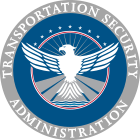
Back Federal Air Marshal Service Czech Servicio Federal de Agentes Aéreos de los Estados Unidos Spanish Federal Air Marshal Service French Դաշնային օդային մարշալ ծառայություն Armenian 連邦航空保安局 Japanese Federal Air Marshal Service Dutch Федеральная служба воздушных маршалов Russian Federal Air Marshal Service Slovenian Федеральна служба повітряних маршалів Ukrainian 联邦空中警察署 Chinese
| Transportation Security Administration Office of Law Enforcement/Federal Air Marshal Service | |
|---|---|
 The insignia of the parent agency, the TSA | |
 The badge of the Federal Air Marshal Service | |
 Flag of the parent agency, the Transportation Security Administration | |
| Common name | Federal Air Marshal Service |
| Abbreviation | OLE/FAMS or FAMS |
| Motto | Invisus, Inauditus, Impavidus (English: "Unseen, Unheard, Unafraid") |
| Agency overview | |
| Formed | March 2, 1962 |
| Annual budget | $805 million (2014)[1] |
| Jurisdictional structure | |
| Federal agency (Operations jurisdiction) | United States |
| Operations jurisdiction | United States |
| Legal jurisdiction | Transportation systems |
| General nature | |
| Specialist jurisdictions |
|
| Operational structure | |
| Federal Air Marshals | 3,000 (estimated)[2][3] |
| Parent agency executives responsible |
|
| Agency executives | |
| Parent agency | Transportation Security Administration |
| Programs | |
| Divisions | List
|
| Website | |
| Official Website | |
| The exact number of Federal Air Marshals is considered sensitive security information by the TSA.[3] | |
The Federal Air Marshal Service (FAMS) is a United States federal law enforcement agency under the supervision of the Transportation Security Administration (TSA) of the United States Department of Homeland Security (DHS).
Because of the nature of their occupation, federal air marshals (FAMs) travel often. They must also train to be highly proficient marksmen. A FAM's job is to blend in with other passengers on board aircraft and rely heavily on their training, including investigative techniques, criminal terrorist behavior recognition, firearms proficiency, aircraft-specific tactics, and close quarters self-defense measures to protect the flying public.[6][7]
- ^ "Homeland security thins air marshal ranks". CNN. 25 February 2014.
- ^ Nixon, Ron (April 25, 2018). "Scandals and Investigations, but Few Arrests, for Air Marshals Program". The New York Times. Retrieved May 2, 2018.
It has since grown from about a dozen air marshals to a force that officials have said numbers about 3,000
- ^ a b "Survey of Federal Civilian Law Enforcement Functions and Authorities" (PDF). Government Accountability Office. December 2007. Retrieved May 2, 2018.
Excluded from the total is the number of Transportation Security Administration's (TSA) Federal Air Marshals, which is Sensitive Security Information (SSI).
- ^ "Executive Assistant Administrator/Director for the Law Enforcement/Federal Air Marshal Service". Transportation Security Administration. Retrieved 20 January 2023.
- ^ "Deputy Executive Assistant Administrator/Deputy Director Law Enforcement/Federal Air Marshal Service". Transportation Security Administration. Retrieved 20 January 2023.
- ^ Clay Biles. How to Stop a Hijacking: Critical Thinking in Civil Aviation Security.
- ^ "Federal Air Marshals". TSA. Archived from the original on 2013-04-11. Retrieved 2013-03-29.